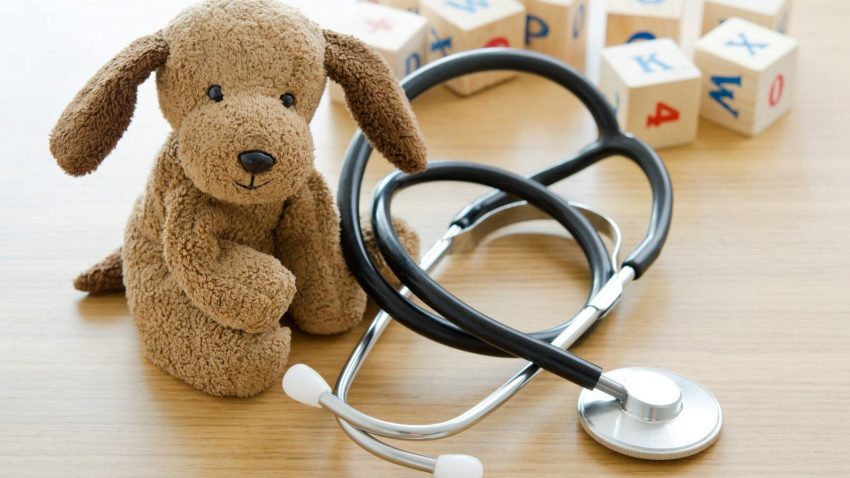

The Importance of Child-Friendly Equipment in a Pediatric Healthcare Setting for Patients Aged 1 to 4
Young children depend on adults for almost everything, and it is the duty of grown-ups to ensure each child grows up safely and happily. Within pediatric medicine, it is the responsibility of each professional to not only support the child’s physical health, but to minimize pain, trauma and emotional distress. This article will talk about ways to decrease fears and tears through the use of child-friendly equipment and surroundings.
This article is intended for clinicians who work within a healthcare setting that treats young children aged one to four years old. Babies who are less than a year old require a different kind of care, as do children aged 5+. This article focuses on one of the most demanding age groups; these children will most likely be very loud, they will be very messy and they will be very energetic. Because these children require a special kind of care, here are some tools and resources available to work with these kids.
What is a Child-Friendly Environment?
A child-friendly environment refers to a place that is safe, comforting and mentally stimulating for a child. This article focuses specifically on the use of child-friendly equipment and surroundings to further medical care in young children aged 1 to 4 years. For example:
- Walls painted colorfully or decorated with stickers, pictures, etc.
- Toys for children of all ages, special toys for children with impairments or disabilities, e.g. – sensory toys for blind children.
- Basic equipment with fun designs, e.g. – blood pressure cuffs with a jungle design, pulse oximeters with stars etc.
- Sensory books for infants, story books for children.
- A selection of multicolored/patterned bandages for the child to choose from.
- Child life specialists to help the child and their family cope with medical care.
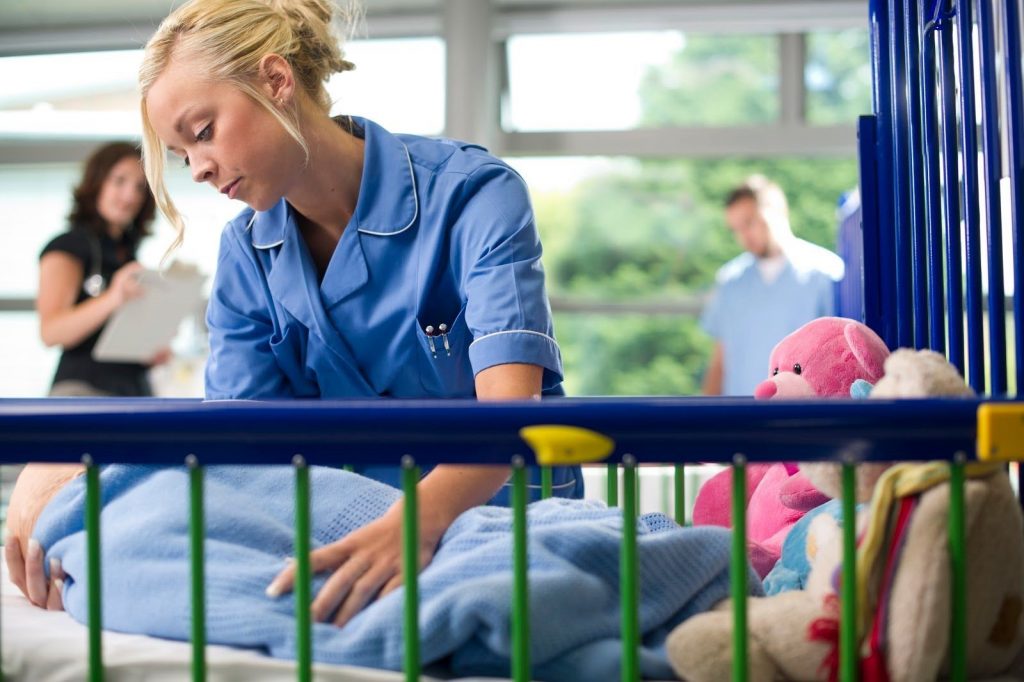
Developmental Milestones and Suggestions for Each Age Group
1 year to 18 months
For infants, 12 months is a busy time and the world is full of new and exciting things. 50% of babies are walking by their 1st birthday and most will follow within the next few months. They’re ready to explore and at this point, most will have developed a noticeable personality, they will be speaking a few recognizable words and will be responding well to creative play.
- Many are still being breastfed alongside other foods, this is not just a way to nourish but a form of comfort and for this there should be a safe place for mother and baby.
- Soft toys (e.g. – stuffed animals) are particularly loved by this age group and can be used to calm the baby and keep them occupied.
- Different textures, noises and colors are fondly noticed by them and so child-friendly dressings/equipment are a good way of distracting the baby.
18 months to 2 years
By now, the vast majority of children are toddling. They are able to string phrases and sentences together, as well as developing a range of cognitive skills. They have strong enough motor skills to carry out basic activities such as scribbling, building blocks and throwing a tennis ball.
- You’ll notice that most children this age are always on the go, therefore it’s best to find a way to keep the child occupied (using toys, story books, etc.) while examining them, don’t expect them to sit still for any length of time.
- Every child develops at their own speed, but some will be transitioning from a crib to a bed, this should be recognized but with caution. Specially designed pediatric hospital beds should be used as they can be lower to the ground, with padded half railings at the sides which can be put up in the early stages.
- This age group is highly active, easily distracted and their emotions are right on the surface. Comfort is the most important form of interaction for them while in a hospital environment, but this no longer just mean hugs and affection, it means stories and play time too.
2 years
This is an age of vital emotional development. It is also one of the most demanding ages and it’s imperative that, in a medical environment, they are treated by professionals with an understanding of children this young and that they are given distraction from any painful or frightening procedures.
- By now, the child will be developing some grown-up skills, such as running, feeding and toilet training. It’s important that the medical staff encourage these progressions and allow children to remain quite independent, while remembering that they will still need a great deal of help in many areas, such as dressing and personal hygiene. They’re developing skills like kicking a ball, climbing onto furniture and copying simple shapes. They recognize some colors and common pictures.
- It’s common for children to regress a little when in hospital, but by providing the right child-friendly equipment you can minimize this. Things like potties, step stools and an enclosed area for children to run around safely are all necessities at this stage. The development at this stage of life is vital and their ability to develop at a similar rate as their peers will affect them for the rest of their lives.
3 years
Children are now at a wonderful time in their lives where magic and monsters become very real to them and this is the point where toddlers can flourish, given the right environment. This age group can identify their name, age and sex, as well as the names and sex of others.
They are typically very active, have a vivid imagination and are becoming skilled in the basics of life, such as feeding, toileting and communication. Strangers can understand most of what they say and you’ll find that they are beginning to talk a lot about the things they are interested in, such as trains, princesses or animals.
They’re beginning to develop dexterity and are typically capable of copying letters and shapes, using scissors and putting small puzzles together. There are physical developments too such as balance, strength and coordination. Most three year olds can ride a tricycle and many are capable of riding a balance bike.
- They’re climbing things with confidence, so it’s important to make sure hospital furniture is secure and that these kids have things to occupy them in order to prevent accidents.
- Distraction is now a powerful tool during procedures, as their imaginations are wild, for example telling amusing stories and playing fantasy games.
4 years
By now, children should have the ability to socialize well with both children and adults. They’ll develop friendships and gauge an understanding of fairness and kindness. Children this age thrive on routine, many start following a familiar routine without prompting. They’re beginning to read simple words, write letters and numbers, and count to 10. They’re no longer toddlers, they’re preschoolers with a clear idea of their identity.
Physically, they’re forming skills such as hopping, skipping and riding a bicycle. They’re typically developing specific interests that can be appealed to in hospital settings.
- For example, some become obsessed with a particular character, talking about them or playing with them is a great method of distraction.
- They’re old enough to understand the difference between right and wrong, and the rewards/punishments that occur for such behavior, like stickers and time outs. These are good incentives.
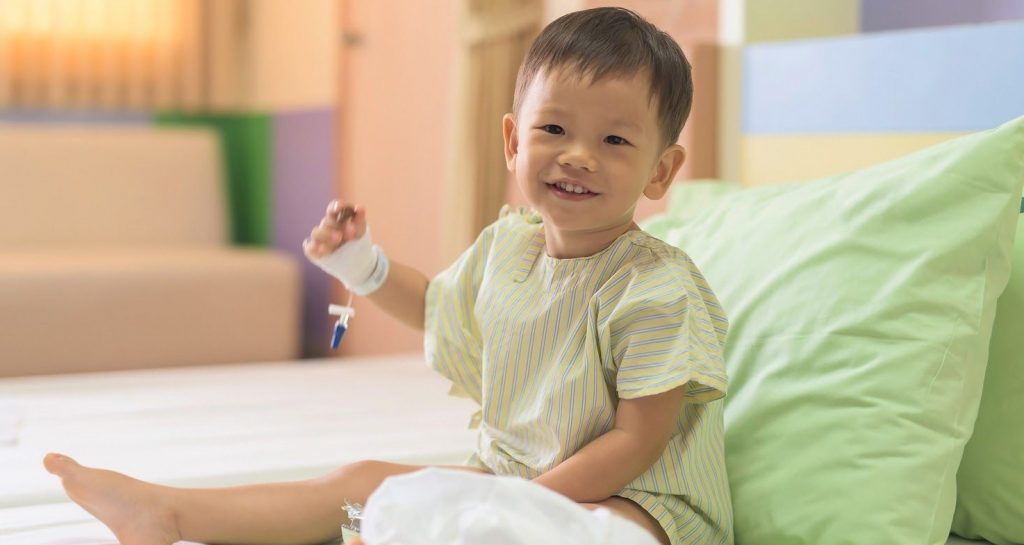
What benefits do these have for children, parents and medical staff?
1. Reduces Pain & Fear
For the child: Fear is common in children throughout a procedure, however a build up of anxiety can psychologically increase pain. For example, a cannula insertion is traumatic for a young child. The tourniquet nips/squeezes the arm tightly and the sharp needle pierces the skin and vein, resulting in bleeding. Sometimes it’s unsuccessful, meaning it must be repeated. It’s unpleasant, however by using pediatric equipment (distracting toys, patterned window IV dressings etc.) you can reduce the fear and pain that the child has to go through.
For the parent: Seeing their child terrified or in pain is something parents dread, especially when they’re so young. So having a child in the hospital is a nightmare for most parents. By providing the child with a less traumatic experience, you are in turn providing the parents with relief from the prospect of having to watch their child cry and scream out of terror or unnecessary pain.
For the medical staff: Children this young often run on instinct, not logic. If they’re in pain or scared they will cry and move away. This can often result in medical staff having to cannulate a moving target. This takes time and being the cause of such distress can be emotionally exhausting. Reduced pain and fear produces a calmer child and procedures are faster, easier and less upsetting for the medical professional.
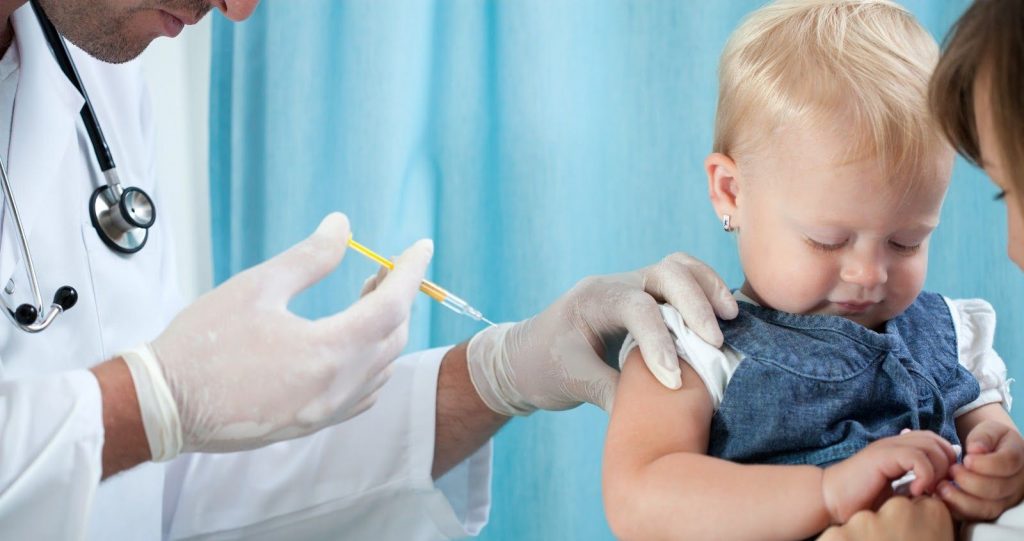
2. Allows for Distraction
For the child: Distraction is key with younger children. For example, a vaccination is scary for any child: the pain is minimal, but for many children just the thought of a needle is terrifying, However, with child-friendly equipment it’s easy enough to distract them. The distractor can capture the child’s attention, be it with a book, a toy or whatever else is age appropriate. If the child is occupied the procedure is fast and all they feel is a sharp scratch. Tell the child it’s over, praise them and let them choose a special band aid. This creates a less stressful experience for the child.
For the parents: Distraction is perfect for the parents as it allows them to be involved in their child’s medical care and allows them to feel some control as they help their child. Often, the parents are the best people to do this job because they know what their child enjoys and how to keep them focused. Child-friendly equipment enables this and gives the parent a choice of distractions.
For the medical staff: In pediatric medicine, distraction is encouraged to help children through procedures. However, medical staff also benefit from this. The distraction, ironically, allows the professional to focus. For example, if the child is pulling away or screaming, it can turn a simple 5 second vaccination into a half hour battle. If the child’s distracted and their attention is elsewhere, the medical professional can concentrate and get the procedure done faster and with ease.
3. Creates a Happier Atmosphere
For the child: It’s proven that different colors and patterns have a direct impact on mood and emotion. Children under 3 prefer warm colors, specifically reds, oranges and yellows. After 3 they start liking a wider range of colors, such as pinks, blues and greens. In a pediatric healthcare setting, paint walls, if possible, in calm colors and have equipment with brighter colors. Machines can be scary to little ones, but if the machine is brightly colored or attachments are patterned, you are likely to see a happier child. These basic changes can prevent the pain of failed procedures, boost the mood and provide a sense of joy that is absent in regular hospital wards.
For the parents: If children are hospitalized, it is almost as if parents are too. Many parents refuse to leave their child’s bedside and will live right there in the hospital. Even for adults, the white walls, grey floor and beige seating can become a little too depressing. Not only does color and pattern heighten a person’s mood, but it can actually help prevent mental health issues like depression and anxiety.
For the medical staff: Working with sick children on a daily basis can be tough, especially if the children are miserable. Happy patients make happier staff and that boost in mood increases job performance, leading to a higher standard of care. Additionally, color stimulates the brain and senses leading to heightened awareness and the ability to think clearer. Diagnosing patients is simpler and new symptoms are noticed faster. Psychosomatic symptoms will be less likely too.
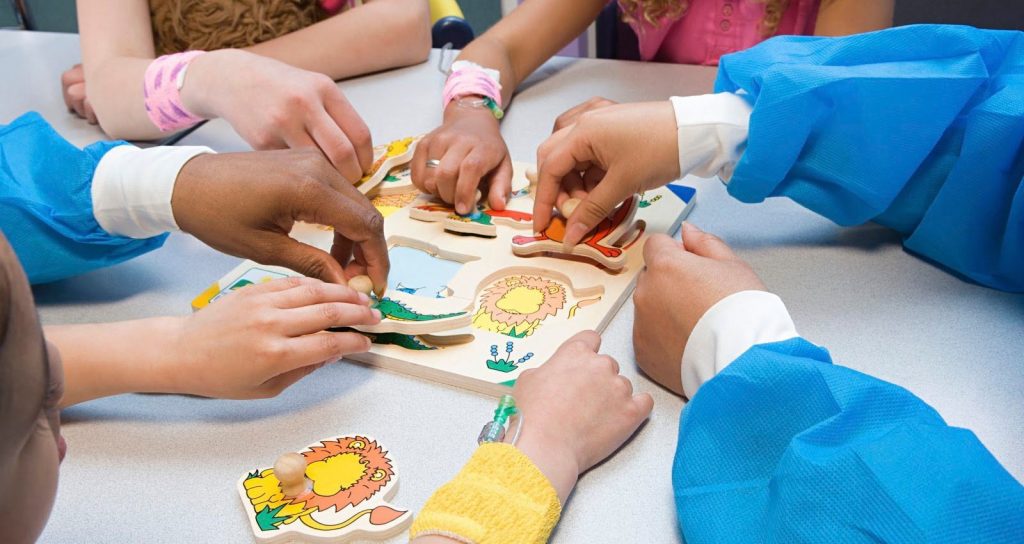
4. Replaces Boredom With Fun
For the child: Child-friendly equipment doesn’t just mean colorful bandages and patterned gowns, it means anything to help sick children get the same experiences as healthy children. They may not be able to kick a ball or fly a kite, but they can still have fun. Stuffed animals, television, art supplies etc. These are the things that allow kids to just be kids, the things that take away the boring and sad days of bed rest, and the things that give children a distraction from the pain they are suffering.
For the parents: Toys and other equipment give parents the chance to continue bonding with their child, the ability to cheer their child up and a break from having to constantly occupy them. Many families bring toys from home, however when a child is admitted unexpectedly or in a hospital too far away, a hospital stocking toys is very important. It means parents can focus on their child, rather than running backwards and forwards for comfort items.
For the medical staff: When working with multiple young children, it can be hard to keep each of them happy and occupied. However, if there are enough things to play with, many children can keep themselves happy and occupied, decreasing stress for nurses and play specialists, while allowing them to spend time with the children who need them most (such as children going through procedures and children who really need social time).
5. Minimizes Risk and Reduces Trauma
For the child: Child-friendly equipment has important safety benefits. The child will be calmer, meaning less squirming and less risk. For example, if a child needs a small procedure (under local anesthetic) to remove a skin lesion, it would be far safer when implementing child-friendly equipment. The play specialist should have plenty of distraction on hand to reduce movement and distress. The anesthetic injection is the only painful part, they won’t feel the procedure and will most likely only panic and move if they can see the removal taking place.
For the parents: Having a sick or injured child is hard enough without watching their procedure go wrong, especially when it could have been avoided with the proper equipment. Distraction items are fantastic for the children, however there are other items that simply give peace of mind to the parents. A screen is a good example of this as it can be highly useful in preventing panic by blocking the potentially gruesome operation taking place, reducing any psychological trauma.
For the medical staff: From a purely functional standpoint, a reduction in accidents prevents legal issues. If the child is calm and occupied, they’re less likely to move, making surgeries safer and more successful. Also, almost all pediatric professionals care about children, and being the cause of their trauma can be deeply upsetting. The outcome of procedures is always better with a relaxed, happy child.
Young Children Require Special Care
Children of this age group require care like no other. These few years consist of exceptional development as their personalities and individual identities blossom. It is vital for young children to be treated by healthcare professionals who understand their needs and behaviors. You can make a difference in the lives of sick children and give them the opportunity to be happy and healthy once again.


5 thoughts on “The Importance of Child-Friendly Equipment in a Pediatric Healthcare Setting for Patients Aged 1 to 4”
Comments are closed.